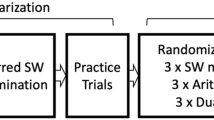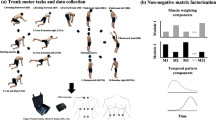Abstract
This study investigated effects of cognitive dual-task interference and task prioritization instructions on task performance and trunk control during a dynamic balance task in persons with and without recurrent low back pain (rLBP). First, we tested the hypothesis that those with rLBP rely more on cognitive resources than back-healthy controls, and therefore trunk kinematics would be altered under dual-task interference conditions. Then, we tested participants’ ability to modulate task performance in accord with prioritization instructions. Persons with and without rLBP (n = 19/group) performed the Balance-Dexterity Task, which involved single-limb balance while compressing an unstable spring with the other limb, with and without a cognitive task engaging verbal working memory. Trunk coupling was quantified with the coefficient of determination (R2) of an angle–angle plot of thorax–pelvis frontal plane motion. Task performance was quantified using variability of spring compression force and of cognitive task errors. Trunk coupling in the rLBP group was lower than that of the back-healthy control group in the single-task condition (p = 0.024) and increased in the dual-task condition (p = 0.006), abolishing the difference between groups. Significant main effects of task prioritization instruction on performance were observed with no differences between groups, indicating similar performance modulation. Cognitive task error variability decreased with a switch from a single- to dual-task condition, exposing an unexpected facilitation effect. We interpret these findings in the context of movement-specific reinvestment and action-specific perception theories as they pertain to cognitive contributions to posture and how the dual-task interference paradigm may influence those contributions.




Similar content being viewed by others
References
Baecke JA, Burema J, Frijters JE (1982) A short questionnaire for the measurement of habitual physical activity in epidemiological studies. Am J Clin Nutr 36:936–942. https://doi.org/10.1093/ajcn/36.5.936
Brumagne S, Diers M, Danneels L et al (2019) Neuroplasticity of sensorimotor control in low back pain. J Orthop Sports Phys Ther 49:402–414. https://doi.org/10.2519/jospt.2019.8489
Buszard T, Farrow D, Zhu FF, Masters RSW (2016) The relationship between working memory capacity and cortical activity during performance of a novel motor task. Psychol Sport Exerc 22:247–254. https://doi.org/10.1016/j.psychsport.2015.07.005
Carlsson AM (1983) Assessment of chronic pain. I. Aspects of the reliability and validity of the visual analogue scale. Pain 16:87–101. https://doi.org/10.1016/0304-3959(83)90088-X
Chiviacowsky S, Campos T, Domingues MR (2010) Reduced frequency of knowledge of results enhances learning in persons with Parkinson’s disease. Front Psychol 1:1–6. https://doi.org/10.3389/fpsyg.2010.00226
Crosbie J, de Faria NFR, Nascimento DP, Ferreira P (2013) Coordination of spinal motion in the transverse and frontal planes during walking in people with and without recurrent low back pain. Spine (Phila Pa 1976) 38:E286–E292. https://doi.org/10.1097/BRS.0b013e318281de28
Deyo RA, Dworkin SF, Amtmann D et al (2014) Report of the NIH Task Force on research standards for chronic low back pain. J Pain 15:569–585. https://doi.org/10.1016/j.jpain.2014.03.005
Etemadi Y, Salavati M, Arab AM, Ghanavati T (2016) Balance recovery reactions in individuals with recurrent nonspecific low back pain: effect of attention. Gait Posture 44:123–127. https://doi.org/10.1016/j.gaitpost.2015.11.017
Fairbank JC, Pynsent PB (2000) The Oswestry disability index. Spine (Phila Pa 1976) 25:2940–2952. https://doi.org/10.1097/00007632-200011150-00017
Fraizer E, Mitra S (2008) Methodological and interpretive issues in posture–cognition dual-tasking in upright stance. Gait Posture 27:271–279. https://doi.org/10.1016/j.gaitpost.2007.04.002
Goh H-T, Sullivan KJ, Gordon J et al (2012) Dual-task practice enhances motor learning: a preliminary investigation. Exp Brain Res 222:201–210. https://doi.org/10.1007/s00221-012-3206-5
Hazamy AA, Altmann LJP, Stegemöller E et al (2017) Improved cognition while cycling in Parkinson’s disease patients and healthy adults. Brain Cogn 113:23–31. https://doi.org/10.1016/j.bandc.2017.01.002
Hodges P, van den Hoorn W, Dawson A, Cholewicki J (2009) Changes in the mechanical properties of the trunk in low back pain may be associated with recurrence. J Biomech 42:61–66. https://doi.org/10.1016/j.jbiomech.2008.10.001
Hodges PW (2001) Changes in motor planning of feedforward postural responses of the trunk muscles in low back pain. Exp Brain Res 141:261–266. https://doi.org/10.1007/s002210100873
Hodges PW, Tucker K (2011) Moving differently in pain: a new theory to explain the adaptation to pain. Pain 152:S90–S98. https://doi.org/10.1016/j.pain.2010.10.020
Huang C-Y, Chang G-C, Tsai Y-Y, Hwang I-S (2016) An Increase in postural load facilitates an anterior shift of processing resources to frontal executive function in a postural–suprapostural task. Front Hum Neurosci 10:1–16. https://doi.org/10.3389/fnhum.2016.00420
Jacobs JV, Roy CL, Hitt JR et al (2016) Neural mechanisms and functional correlates of altered postural responses to perturbed standing balance with chronic low back pain. Neuroscience 339:511–524. https://doi.org/10.1016/j.neuroscience.2016.10.032
Karayannis NV, Smeets RJEM, van den Hoorn W, Hodges PW (2013) Fear of movement is related to trunk stiffness in low back pain. PLoS ONE 8:e67779. https://doi.org/10.1371/journal.pone.0067779
Lamoth CJC, Stins JF, Pont M et al (2008) Effects of attention on the control of locomotion in individuals with chronic low back pain. J Neuroeng Rehabil 5:1–8. https://doi.org/10.1186/1743-0003-5-13
Liu YC, Yang YR, Tsai YA, Wang RY (2017) Cognitive and motor dual task gait training improve dual task gait performance after stroke—a randomized controlled pilot trial. Sci Rep 7:1–8. https://doi.org/10.1038/s41598-017-04165-y
Masters R, Maxwell J (2008) The theory of reinvestment. Int Rev Sport Exerc Psychol 1:160–183. https://doi.org/10.1080/17509840802287218
Norouzi E, Vaezmosavi M, Gerber M et al (2019) Dual-task training on cognition and resistance training improved both balance and working memory in older people. Phys Sportsmed. https://doi.org/10.1080/00913847.2019.1623996
Norton G, McDonough CM, Cabral HJ et al (2016) Classification of patients with incident non-specific low back pain: implications for research. Spine J 16:567–576. https://doi.org/10.1016/j.spinee.2015.08.015
Ojha HA, Kern RW, Lin C-HJ, Winstein CJ (2009) Age affects the attentional demands of stair ambulation: evidence from a dual-task approach. Phys Ther 89:1080–1088. https://doi.org/10.2522/ptj.20080187
Pakzad M, Fung J, Preuss R (2016) Pain catastrophizing and trunk muscle activation during walking in patients with chronic low back pain. Gait Post 49:73–77. https://doi.org/10.1016/j.gaitpost.2016.06.025
Reeves NP, Cholewicki J, van Dieën JH et al (2019) Are stability and instability relevant concepts for back pain? J Orthop Sport Phys Ther. https://doi.org/10.2519/jospt.2019.8144
Roelofs J, Peters ML, Fassaert T, Vlaeyen JWS (2005) The role of fear of movement and injury in selective attentional processing in patients with chronic low back pain: a dot-probe evaluation. J Pain 6:294–300. https://doi.org/10.1016/j.jpain.2004.12.011
Rowley KM, Gordon J, Kulig K (2018) Characterizing the balance-dexterity task as a concurrent bipedal task to investigate trunk control during dynamic balance. J Biomech 77:211–217. https://doi.org/10.1016/j.jbiomech.2018.07.014
Rowley KM, Kulig K (2019) Highlighting distinctions between discrete perturbations and continuous perturbations in the study of dynamic trunk control [September 2019 Letter to the Editor-in-Chief]. J Orthop Sports Phys Ther 49:679–681. https://doi.org/10.2519/jospt.2019.0201
Rowley KM, Smith JA, Kulig K (2019) Reduced trunk coupling in persons with recurrent low back pain is associated with greater deep-to-superficial trunk muscle activation ratios during the balance-dexterity task. J Orthop Sports Phys Ther 49:887–898. https://doi.org/10.2519/jospt.2019.8756
Schmidt RA, Lee TD (2005) Motor control and learning: a behavioral emphasis, 4th edn. Human Kinetics, Champaign
Smith JA, Gordon J, Kulig K (2017) The influence of divided attention on walking turns: effects on gait control in young adults with and without a history of low back pain. Gait Post 58:498–503. https://doi.org/10.1016/j.gaitpost.2017.09.019
De Troyer A, Estenne M, Ninane V et al (1990) Transversus abdominis muscle function in humans. J Appl Physiol 68:1010–1016
van den Hoorn W, Bruijn SM, Meijer OG et al (2012) Mechanical coupling between transverse plane pelvis and thorax rotations during gait is higher in people with low back pain. J Biomech 45:342–347. https://doi.org/10.1016/j.jbiomech.2011.10.024
van Dieën JH, Reeves NP, Kawchuk G et al (2018a) Analysis of motor control in low-back pain patients: a key to personalized care? J Orthop Sports Phys Ther. https://doi.org/10.2519/jospt.2019.7916
van Dieën JH, Reeves NP, Kawchuk G et al (2018b) Motor control Changes in low-back pain: divergence in presentations and mechanisms. J Orthop Sports Phys Ther. https://doi.org/10.2519/jospt.2019.7917
Wickens CD (2002) Multiple resources and performance prediction. Theor Issues Ergon Sci 3:159–177. https://doi.org/10.1080/14639220210123806
Winter DA, Patla AE, Frank JS (1990) Assessment of balance control in humans. Med Prog Technol 16:31–51
Witt JK (2017) A Role for control in an action-specific effect on perception. J Exp Psychol Hum Percept Perform 43:1791–1804. https://doi.org/10.1037/xhp0000447
Witt JK (2011) Action’s effect on perception. Curr Dir Psychol Sci 20:201–206. https://doi.org/10.1177/0963721411408770
Witt JK, Linkenauger SA, Bakdash JZ et al (2009) The long road of pain: chronic pain increases perceived distance. Exp Brain Res 192:145–148. https://doi.org/10.1007/s00221-008-1594-3
Acknowledgements
We thank Faye Weinstein, PhD, Clinical Associate Professor at Keck School of Medicine, for her insight and consultation, which helped us understand the associations with self-report measures of task difficulty. This research was supported by the American Society of Biomechanics Graduate Student Grant-In-Aid and the International Society of Biomechanics Matching Dissertation Grant.
Author information
Authors and Affiliations
Corresponding author
Ethics declarations
Conflict of interest
The authors declare that they have no conflict of interest.
Ethical approval
All procedures performed in studies involving human participants were in accordance with the ethical standards of the institutional and national research committee and with the 1964 Helsinki declaration and its later amendments or comparable ethical standards.
Additional information
Communicated by John C. Rothwell.
Publisher's Note
Springer Nature remains neutral with regard to jurisdictional claims in published maps and institutional affiliations.
Rights and permissions
About this article
Cite this article
Rowley, K.M., Winstein, C.J. & Kulig, K. Persons in remission from recurrent low back pain alter trunk coupling under dual-task interference during a dynamic balance task. Exp Brain Res 238, 957–968 (2020). https://doi.org/10.1007/s00221-020-05772-4
Received:
Accepted:
Published:
Issue Date:
DOI: https://doi.org/10.1007/s00221-020-05772-4




